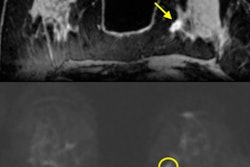Dear Women's Imaging Insider,
Are you detecting as many extra cancers as you could be? Perhaps not.
A large U.K. trial has revealed that extended ipsilateral breast ultrasound can detect a significant number of extra cancers compared with the standard screening protocol alone. Less effect was demonstrated for complete contralateral breast ultrasound, according to the researchers. Read all about it here.
Everyone knows breast MRI has a high sensitivity, whether that's dynamic contrast-enhanced MRI (DCE-MRI) or diffusion-weighted imaging (DWI-MRI). The trouble is, DCE-MRI picks up everything -- benign or malignant. And DWI-MRI? It doesn't detect everything, but it accurately distinguishes between benign and malignant breast lesions.
What happens when these two techniques are put together? That's precisely what researchers from New York City and Vienna sought to determine. Discover their results.
Hyperechogenic breast lesions are rare and described as generally benign. That being the case, these lesions are often overlooked and a biopsy is not generally recommended. But is that wise? New research suggests it is not the ideal approach. Reporting its findings at ECR 2018, a research team from Chile found that hyperechogenic lesions can be malignant and must be imaged with that possibility in mind.
Also in your Women's Imaging Community, we have news about digital breast tomosynthesis (DBT). The modality is only slightly more expensive than digital mammography, according to a study from Italy. DBT costs only 20% more, but it detects 40% more cancers, the researchers found. Read more.
The average size of breast tumors has increased significantly since 2001, and this may reflect declining screening rates, researchers reported at the European Breast Cancer Conference in Barcelona, Spain. The finding is in stark contrast to the 1980s and 1990s, when the average size of tumors decreased dramatically.
The group from the U.K. scrutinized more than 350,000 women from the 1980s to more recently. The researchers categorized the women by age and tumor size, finding tumor size has increased.
Be sure to head on over to the Women's Imaging Community to read other stories that will interest you. And as always, I enjoy hearing from you, so contact me anytime.




















